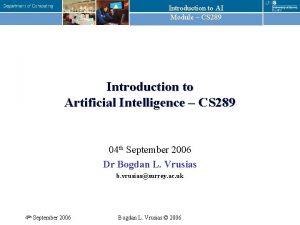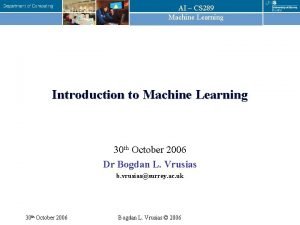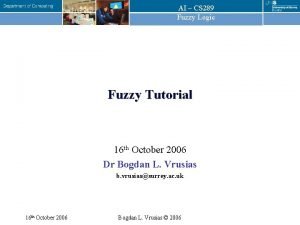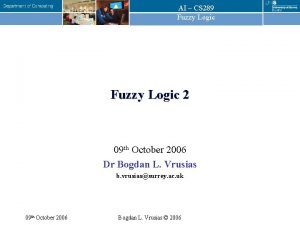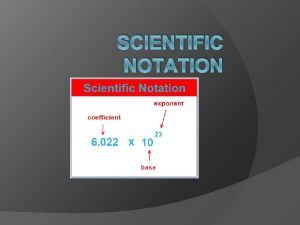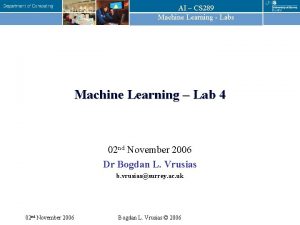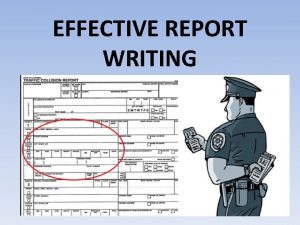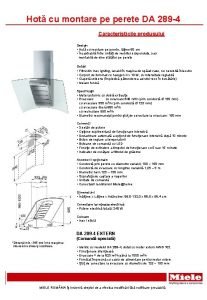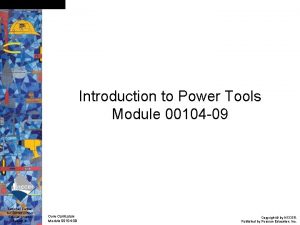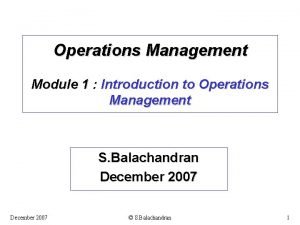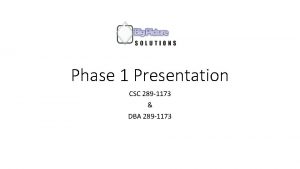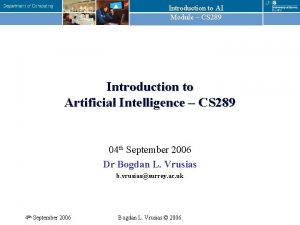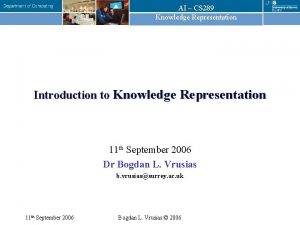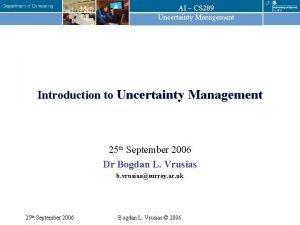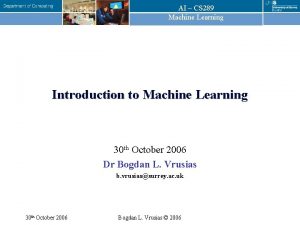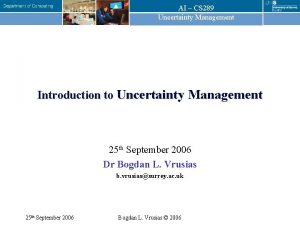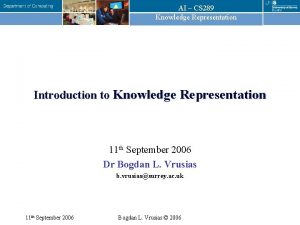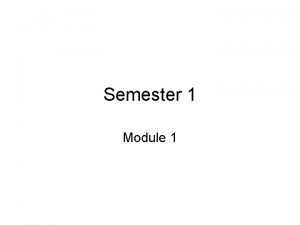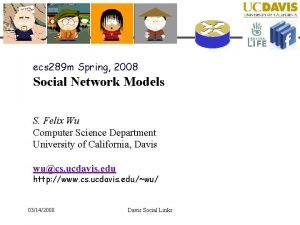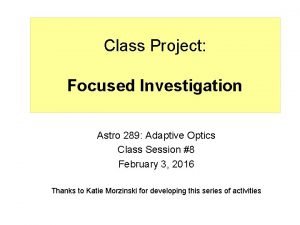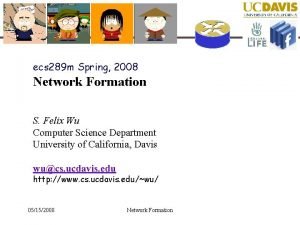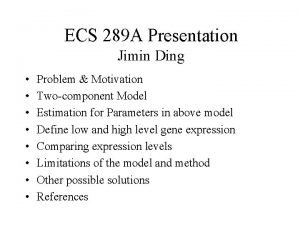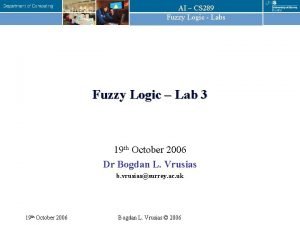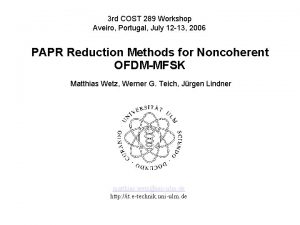Introduction to AI Module CS 289 Introduction to

























- Slides: 25

Introduction to AI Module – CS 289 Introduction to Artificial Intelligence – CS 289 04 th September 2006 Dr Bogdan L. Vrusias b. vrusias@surrey. ac. uk 4 th September 2006 Bogdan L. Vrusias © 2006

Introduction to AI Module – CS 289 Fundamental Questions of AI (Alan Turing asked: ) Is there thought without experience? Is there mind without communication? Is there language without living? Is there intelligence without life? … Can machines think? 4 th September 2006 Bogdan L. Vrusias © 2006 2

Introduction to AI Module – CS 289 Aims • The aim of this module is: – This module aims to demonstrate a variety of techniques for capturing human knowledge and represent it in a computer, in a way that enables the machine to reason over the data represented, and mimic the human ability to deal with incomplete or uncertain data. 4 th September 2006 Bogdan L. Vrusias © 2006 3

Introduction to AI Module – CS 289 Outcomes • At the end of the module students should be able to: – Describe methods for acquiring human knowledge. – Evaluate which of the acquisition methods would be most appropriate in a given situation. – Describe techniques for representing acquired knowledge in a way that facilitates automated reasoning over the knowledge. – Categorise and evaluate AI techniques according to different criteria such as applicability and ease of use, and intelligently participate in the selection of the appropriate techniques and tools, to solve simple problems. – Use the presented techniques in practice to develop an “intelligent” system. 4 th September 2006 Bogdan L. Vrusias © 2006 4

Introduction to AI Module – CS 289 Content I • Knowledge-Based Intelligent Systems – Artificial intelligence from the ‘Dark Ages’ to knowledge-based systems – What is knowledge? – Knowledge representation techniques – Rules as a knowledge representation technique and Expert Systems 4 th September 2006 Bogdan L. Vrusias © 2006 5

Introduction to AI Module – CS 289 Content II • Uncertainty Management in Expert Systems – Introduction to uncertainty – Bayesian reasoning – Certainty factors theory and evidential reasoning 4 th September 2006 Bogdan L. Vrusias © 2006 6

Introduction to AI Module – CS 289 Content III • Fuzzy Expert Systems – Fuzzy sets and linguistic variables and hedges – Fuzzy inference for building a fuzzy expert system 4 th September 2006 Bogdan L. Vrusias © 2006 7

Introduction to AI Module – CS 289 Content IV • Machine Learning – – Introduction to learning Decision Trees Introduction to Artificial Neural Networks Introduction to Evolutionary Computation 4 th September 2006 Bogdan L. Vrusias © 2006 8

Introduction to AI Module – CS 289 Content V • Knowledge Engineering and Data Mining – Introduction to knowledge engineering – How to find the tools that will work for my problem – Data mining and knowledge discover 4 th September 2006 Bogdan L. Vrusias © 2006 9

Introduction to AI Module – CS 289 Assessment Pattern Unit(s) of Assessment Weighting Towards Module Mark (%) Coursework 25 Verbal Examination (based on the coursework) 15 Examination 60 Qualifying Condition(s) A weighted aggregate mark of 40% is required to pass the module. 4 th September 2006 Bogdan L. Vrusias © 2006 10

Introduction to AI Module – CS 289 Coursework • The students are expected to participate in a group project focused on studying the architecture and behaviour of an fuzzy logic system. • Students may use a pre-existing program (shell) or write their own. – The department will provide the Matlab Fuzzy Logic tool, – but, there are web sites which contain AI freeware and the students are expected to make the most of this freeware. • The student is expected to write an individual 10 -page (max) report on his or her study, not exceeding 3000 words. – More details will be give at appropriate time. 4 th September 2006 Bogdan L. Vrusias © 2006 11

Introduction to AI Module – CS 289 Methods of Teaching/Learning • The module will consist of 24 hours of lectures, and 6 practical tutorial hours. • NOTE: Attending lectures is VERY important! 4 th September 2006 Bogdan L. Vrusias © 2006 12

Introduction to AI Module – CS 289 On-line Resources • CS 289 main resource – http: //www. cs. surrey. ac. uk/teaching/cs 289 NOTE: Make sure you check the module website regularly! • The WWWW (i. e http: //www. google. com !!!) 4 th September 2006 Bogdan L. Vrusias © 2006 13

Introduction to AI Module – CS 289 Selected Texts • The main course book for this module that contains most of theoretical material is: – Negnevitsky, Michael (2004), Artificial Intelligence – A Guide to Intelligent Systems (Second Edition), Harlow, UK, Addison Wesley, ISBN: 0321204662. 4 th September 2006 Bogdan L. Vrusias © 2006 14

Introduction to AI Module – CS 289 Selected Texts II • Other recommended books are: – Luger, G. F (2004) Artificial Intelligence: Structures & Strategies for Complex Problem Solving (Fifth Edition). London: Addison-Wesley, ISBN: 0321263189. – Callan, Rob (2003), Artificial Intelligence, Basingstoke, Hampshire, UK, Palgrave Mac. Millan, ISBN: 0333801369. – Winston, Patrick H. (1992), Artificial Intelligence (Third Edition), Reading (MASS): Addison-Wesley Publishers Co, ISBN: 0201533774. 4 th September 2006 Bogdan L. Vrusias © 2006 15

Introduction to AI Module – CS 289 Learning contract – for us all • • Punctuality No disruption of other’s learning Mobile phones! Availability (office 06 BB 02): – Tuesdays 14: 00 - 16: 00 • Communication: email and the student hours • Fun 4 th September 2006 Bogdan L. Vrusias © 2006 16

Introduction to AI Module – CS 289 Discussion • Can machines think? • Can machines see? • How does a human mind work? Is it magic? • Can non-humans have minds? • Can machines replace a human worker? • Are intelligent machines good or bad for humans? • Would you trust one? 4 th September 2006 Bogdan L. Vrusias © 2006 17

Introduction to AI Module – CS 289 What is Intelligence? • Intelligence is the ability to understand learn things. • Intelligence is the ability to think and understand instead of doing things by instinct or automatically. • (Essential English Dictionary, Collins, London, 1990). • Intelligence is the ability to learn and understand, to solve problems and to make decisions. 4 th September 2006 Bogdan L. Vrusias © 2006 18

Introduction to AI Module – CS 289 What is Artificial Intelligence? • The goal of artificial intelligence (AI) as a science is to make machines do things that would require intelligence if done by humans. • AI is a branch of computing science that deals with the specification, design and implementation of information systems that have some knowledge related to the enterprise in which the information systems are situated. • Such systems are designed per se to be responsive to the needs of their end-users. 4 th September 2006 Bogdan L. Vrusias © 2006 19

Introduction to AI Module – CS 289 Turing Imitation Game • The British mathematician Alan Turing, over fifty years ago, inventing a game, the Turing Imitation Game. • The imitation game originally included two phases: 4 th September 2006 Bogdan L. Vrusias © 2006 20

Introduction to AI Module – CS 289 Turing Imitation Game – Phase 1 In the first phase, the interrogator, a man and a woman are each placed in separate rooms. The interrogator’s objective is to work out who is the man and who is the woman by questioning them. The man should attempt to deceive the interrogator that he is the woman, while the woman has to convince the interrogator that she is the woman. 4 th September 2006 Bogdan L. Vrusias © 2006 21

Introduction to AI Module – CS 289 Turing Imitation Game – Phase 2 In the second phase of the game, the man is replaced by a computer programmed to deceive the interrogator as the man did. It would even be programmed to make mistakes and provide fuzzy answers in the way a human would. If the computer can fool the interrogator as often as the man did, we may say this computer has passed the intelligent behaviour test. 4 th September 2006 Bogdan L. Vrusias © 2006 Second Phase 22

Introduction to AI Module – CS 289 Turing Remarks • By maintaining communication between the human and the machine via terminals, the test gives us an objective standard view on intelligence. • A program thought intelligent in some narrow area of expertise is evaluated by comparing its performance with the performance of a human expert. • To build an intelligent computer system, we have to capture, organise and use human expert knowledge in some narrow area of expertise. 4 th September 2006 Bogdan L. Vrusias © 2006 23

Introduction to AI Module – CS 289 Some AI Examples • Please check the following websites on your free time: – – – – http: //www. generation 5. org/jdk/demos. asp http: //www. aridolan. com/ofiles/e. Floys. html http: //www. aridolan. com/ofiles/i. Floys. html http: //www. arch. usyd. edu. au/~rob/#applets http: //www. softrise. co. uk/srl/old/caworld. html http: //people. clarkson. edu/~esazonov/neural_fuzzy/loadsway/Load. Sway. htm http: //www. iit. nrc. ca/IR_public/fuzzy/Fuzzy. Truck. html http: //www. pandorabots. com/pandora/talk? botid=f 5 d 922 d 97 e 345 aa 1 4 th September 2006 Bogdan L. Vrusias © 2006 24

Introduction to AI Module – CS 289 Closing • • Questions? ? ? Remarks? ? ? Comments!!! Evaluation! 4 th September 2006 Bogdan L. Vrusias © 2006 25
 Cs 289
Cs 289 Cs 289
Cs 289 Matematika odmocniny
Matematika odmocniny Mech 289
Mech 289 289 in expanded form
289 in expanded form Cs 289
Cs 289 Fuzzy logic tutorial
Fuzzy logic tutorial Cs 289
Cs 289 67x10^6 in scientific notation
67x10^6 in scientific notation Akar pangkat 2 dari 3969
Akar pangkat 2 dari 3969 Cs 289a
Cs 289a 25x^2+64=289
25x^2+64=289 Pg 289
Pg 289 Nac 289
Nac 289 Simplify square root of 132
Simplify square root of 132 Ordinary legislative procedure
Ordinary legislative procedure Szkoła podstawowa 289
Szkoła podstawowa 289 Akar pangkat dari 4356
Akar pangkat dari 4356 289/4
289/4 C device module module 1
C device module module 1 00104-15 - introduction to power tools
00104-15 - introduction to power tools Introduction to construction drawings
Introduction to construction drawings Module 00105 exam introduction to construction drawings
Module 00105 exam introduction to construction drawings Operations management module 1
Operations management module 1 Module 70 introduction to therapy
Module 70 introduction to therapy Introduction to hand tools
Introduction to hand tools
